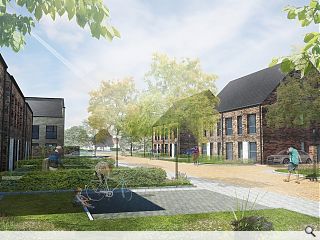Approval granted for 177 home Pennywell development
September 16 2015
Urban Union have obtained planning consent for an additional 177 homes at Pennywell, Edinburgh, in the second phase of a wider master plan to build 719 houses and apartments for the area.Delivered in collaboration with the City of Edinburgh Council the barton Willmore designed scheme will comprise a mixture of two and three storey terraced, semi-detached town houses and three apartment blocks arranged around a village green.
Councillor Cammy Day, housing convener for the City of Edinburgh Council, said: “The construction of the first phase of Pennywell is well underway, and the completed new homes look absolutely fantastic. Bringing good quality houses at prices that hard-working families can afford will encourage people to move into the north of the city, create jobs and in turn, stimulate the economy.”
Work is expected to get underway by the end of the year, delivering a total of 85 houses and 92 flats by next year – 75 of which will be classed as affordable.
3 Comments
#2 Posted by james on 18 Sep 2015 at 13:04 PM
On looking at this image again, I can sense from the perspective that before the photographer set up their tripod, they employed a small group of street urchins to shovel the piles of coal up from the foreground and walked the pit ponies round to the backs of the houses.
Cor blimey! Alright Guv'nor?
Cor blimey! Alright Guv'nor?
#3 Posted by James on 23 Sep 2015 at 09:34 AM
Looks like a converted army barracks...'ten'shun!
Post your comments
Read next: East Calder Partnership Centre plans emerge
Read previous: Expresso Property to host Park Circus consultation
Back to September 2015
Like us on Facebook
Become a fan and share
News Archive
Search News
Features & Reports
For more information from the industry visit our Features & Reports section.




- A factory for living in.
For 'hard-working families', the protestant work ethic now manifests itself in 'Eine Haus des Volkes'. I'll swear I've heard this bollocks before somewhere, sometime?
I wonder, are the architects fully aware of what they are doing (which is highly unlikely), or, as is more likely the case, wholly ignorant of political philosophy? Whatever is the rationale, I just can't believe that these forms and specific iconology have been chosen by accident.
Maybe Barton Willmore would care to respond to this query about their chosen forms and use of an industrialised aesthetic?